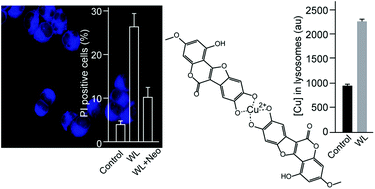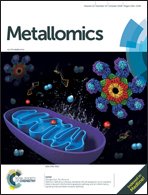Anti-cancer effects of wedelolactone: interactions with copper and subcellular localization
Abstract
Wedelactone (WL), a plant polyphenolic derivative of coumestan, represents a promising anti-cancer agent. The underlying mechanisms of its action are not fully understood and appear to involve interplay with copper ions. Herein, we examined coordination and redox interactions of WL with Cu2+ in phosphate buffer (pH 7), and in two breast cancer cell lines. EPR, UV-Vis and fluorescence spectroscopy showed that WL and Cu2+ build a coordination complex with 2 : 1 stoichiometry and distorted tetrahedral geometry. WL showed strong fluorescence that was quenched by Cu2+. The sequestration of the intracellular copper pool with neocuproine led to a significant drop in the cytotoxic effects of WL, whereas the co-application of Cu2+ and WL and the formation of an extracellular complex suppressed both the cytotoxic effects of WL and copper loading. Fluorescence microscopy showed that WL is mainly localized in the cytosol and significantly less in the nuclei. WL fluorescence was stronger in cells pretreated with neocuproine, implying that the complex of WL and Cu2+ is formed inside the cells. WL caused a two-fold increase in the lysosomal level of copper as well as copper-dependent lysosome membrane permeabilization. On the other hand, the protective effects of overexpression of thioredoxin 1 imply that WL exerts the main oxidative impact inside the nucleus. The interactions of WL with copper may be essential for therapeutic performance and selectivity against cancer cells, taking into account that a number of cancer types, including breast cancer, exhibit increased intratumoral copper levels or altered copper distribution.



 Please wait while we load your content...
Please wait while we load your content...